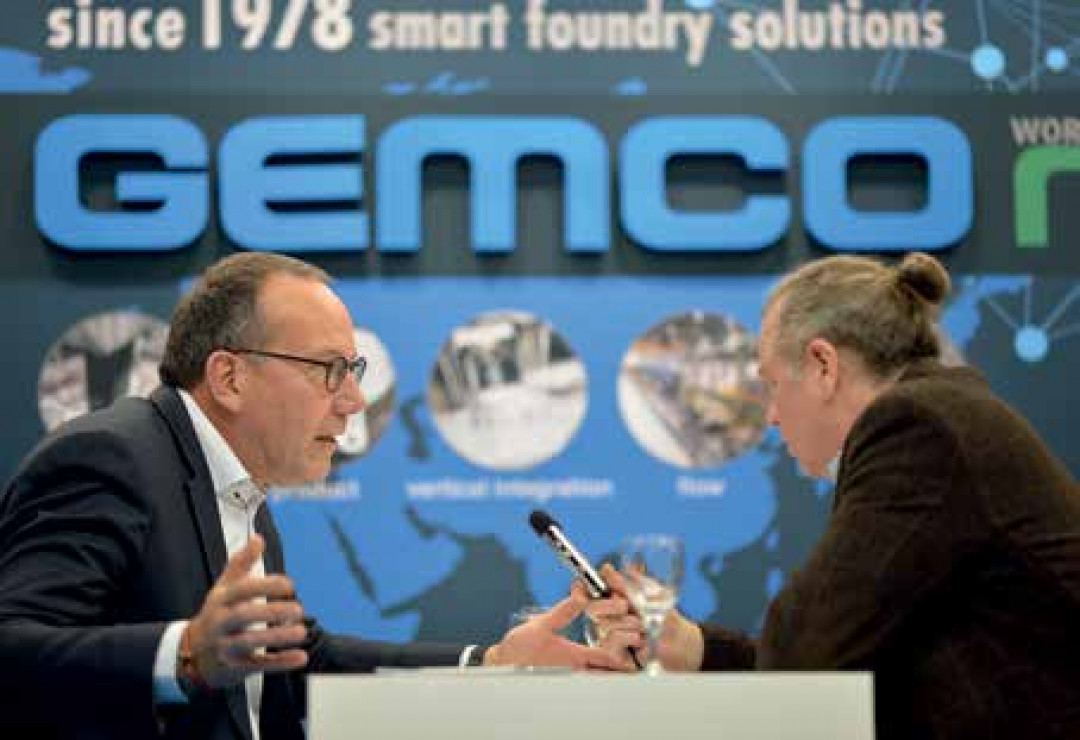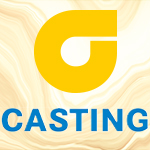

Read an article from CP+T 01/2020: Huub van der Weiden is sales engineer at the Dutch foundry consulting and engineering firm Gemco Engineers. “Market and trends, and now?” – a question that many foundry men are asking – was the title of a presentation given by the former machine developer at a significant German foundry event lately. CP+T met van der Weiden at EUROGUSS to talk about the production site of the future, big data, craftmanship, and new partnerships.
What opportunities do the market situation and current trends offer foundries?
Foundries that react flexibly and personalize their production – adapt to their customers’ requirements – will have opportunities. But companies must be enabled to achieve this, and there is still a lot to do here because personalization means that products must be manufactured in the shortest possible time and their design may change within a year. We therefore speak of short product life times. One of the opportunities this offers is that the foundry engineer can already provide his or her knowledge to the customer during the development phase, instead of the customer coming to the foundry and asking whether the design is possible to cast. The product life cycle actually already starts then, so time can be saved. This is valuable, because there is no ‘start-up time’ involved and production can begin straight away. A win-win situation for all involved.
Why is the product life cycle getting shorter?
Because of market demand. The market now requires less mass production from foundries. We have transitioned from mass production to a time of personalized production, via a period of mass customization. The market has developed from a push to a pull market, so to speak, in which the foundry strategically aligns its range upon whatever the customers’ require – and on-demand production means that lead times must get shorter. Everything is changing much quicker now than in the past. Foundries should be prepared for products that change during the course of just one year. The engineering work must already have taken place at the customer, and the very first cast should completely meet the customer’s requirement in order to optimize use of the production time, eliminating pilot series or order for serial production, because in future customers will mainly want small series. Numerous aspects at the foundries, however, will have to change in order to enable them to provide this flexible personalized production.
Can foundries actually afford to do this?
Yes and no. Though there are solutions for the ‘no’ part! The changes in foundries which are organizational in nature require smaller investments that are rapidly amortized, for example software systems that optimize operating times and zero-defect methods. Greater investment in flexible production and automation that involves more and innovative smart engineering, can be carried out gradually – so these investments can already be amortized with smaller production series. ‘Big data’ contributes towards product require-ments being met from the very first component onwards, and the defect rate being driven down to almost zero. Specialist knowledge, however, is vital in addition to big data. Specialization must still make progress in the foundry sector in order to develop maximum expertise in a particular product group.

And how about the costs?
Although it requires investment to modify foundries, the changes to personalized production offer a good return on investment. There are ways to avoid or minimize costs, particularly when banks are hesitant to provide credits. For example by entering into partnerships.
How do you picture that?
Foundries can enter into partnerships, collaborations. If a foundry does not have the expertise for a particular product group they should not give up their own specialization but join forces with a foundry that does have that specific know-how and that foundry should then handle the production. The task of the foundry that received the enquiry is to ensure that the end-customer is supplied with the right high-quality products. This could also stretch to machining work or even some pre-assembly, depending on what was called for. Each partner’s investment is reduced when foundries work together. What we hear from the sector is that more money is currently coming from partners than from banks. For the sector, and for its future, this means that foundries will become customers of other foundries or suppliers to end-customers. But foundry workforces will also have to acquire additional specialist knowledge because this is a totally different business model.
What risks do foundries face?
The biggest risk is that foundries will wait too long. If you wait, you’re late! The market is not currently saying what will happen in future. Carmakers are being cautious, but life must go on in the foundries. The foundries must work on personalization now, on zero defects, added value, uptime, personnel, traceability, the reduction of run-times, and environmental issues. Then the foundries will already be organizationally set up when it becomes clear which way the market is heading.
What do foundry customers expect from foundries?
Foundries must help their customers by delivering the right quality and quantity. Foundry customers will increasingly expect that they no longer need to concern themselves with the cast product itself, but simply use it in their production lines without any problems. To achieve this, foundries must be capable of production that is appropriate and accurate. Big data analysis will make a contribution, but only if the experience of the foundrymen is exploited in the program. There is, however, a shortage of specialists in many foundries. During discussions on expansions, modernizations, or automations we are always asked how we can improve working conditions so that foundries can keep and attract the right employees. An example: we built an integrated fettling shop in a foundry in Hungary. The product clusters used to come from the foundry and be machined elsewhere at the works – often by lesser qualified local workers because of the type of work and the conditions. The foundry paid these workers by the piece. This seemed to be a cheap solution, but it was ultimately more expensive because the work was hard, uncomfortable and unpopular. We have engineered and installed a fettling line on which one can personalize every workplace. Table height, lighting and ventilation can be adapted to the needs of each individual worker. Now the foundry can carry out its fettling work with its own professionals and without using temporary workers, reducing costs in the long term. But what is more important is that the quality of the product has improved – and that is what customers notice.
What else should foundries adjust to?
If possible, foundries should be prepared to become active abroad. It is not unusual for producers to ask their suppliers whether they want to follow them in moving abroad. If the foundry does not move with the producer they will find another foundry that will. Internationalization also brings about collaborations, for example joint ventures, because the foundries start off with a local partnership and then expand production when the orders come in. We built a foundry in China for Georg Fischer, initially designed for 35,000 tonnes. We expanded it a few years later so that 60,000 tonnes can now be produced there. GF was able to maintain its customer(s) and subsequently expand.
What do you think about the direction of development among carmakers?
That’s very difficult to say. My personal opinion is that the drive of the future will be electric, but that all vehicles will be hybrid. Electricity will be used to propel the car. The electricity will then be efficiently managed by a generator that works in the most efficient rpm range. In the long term I think that the e-car will win the race, but this will not happen overnight.
What solutions does Gemco offer foundries?
Gemco is a foundry consulting, engineering, planning, management and realization service provider. The modern foundries built by Gemco are clean and offer ergonomic workplaces. A high uptime is assured because our added value consists in engineering foundries from the foundrymen‘s point of view. For maintenance work we make sure that the complete plant offers the required easy accessibility. All the IT interfaces have already been planned when we develop a foundry. We build about five foundries simultaneously each year, so we know how to do it and can develop new layouts without restricting ourselves. When we are building an iron foundry we can, for example, exploit experience gained from building an aluminum foundry if it makes sense to do so. Automation, machining and pre-assembly are already found everywhere in aluminum foundries, but the iron foundries need to catch up. Regarding big data, these systems still require input from the foundrymen. We have experts that can assist to implement big data more quickly than when the foundries use their own resources. Big data offers many possibilities, but incorrect input results in incorrect output.
What projects is Gemco currently working on?
The engineering and project management for the new Scania foundry in Sweden is our largest project at the moment. First pour is due at the end of this year. The equipment is currently being installed. Modernizing the foundry for Kamaz in Naberezheney Chelny in Russia is another large project, which is also about reducing current scrap rates. We have just commissioned a green sand foundry in Macedonia, MTI Mexico was a major project, and early in January production started at an iron foundry we built in Egypt. We have new projects in the planning phase in Europe, and we expect some big investment decisions to be made in the next few months. We are also involved in several green sand regeneration projects, and the development of the lost foam process for iron and aluminum casting. There are smaller projects as well. Gemco not only engineers and builds foundries on green-field sites, but also handles every form of modernization – including digitalization of foundries. Big data implementation is a comparatively new item for us but more importantly really, are the analyses and recommendations that must result from it. We also get more and more questions from casting buyers about development and quality assurance. These two topics will become increasingly intertwined in coming years. Gemco offers the appropriate services for foundries.
How have your sales developed?
We have achieved annual sales of 15 to 20 million euros in recent years with the 45 permanent staff we now have. We want to reach 30 million in the coming five years. More and more foundries worldwide are becoming aware of us.
And what is your own background?
I am the Account Manager for Europe and China. I used to develop machines myself, so I have a technical background which is absolutely vital for this work. I joined Gemco in 1997 and concentrated on lost foam until 2001. I then had a lost foam foundry of my own for a while, but returned to Gemco after nine years. I am married, and have four children aged 17 to 22.
Huub van der Weiden was interviewed by Robert Piterek.
You can also find the complete article in the CP+T issue 01/2020.

